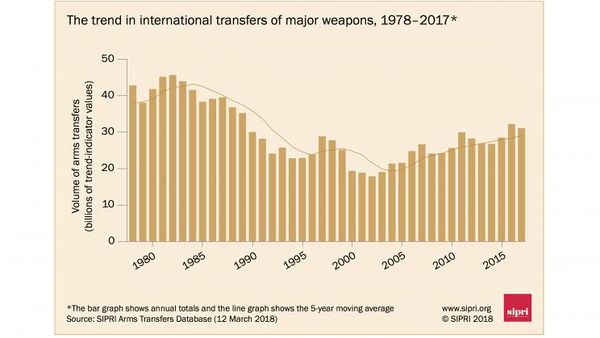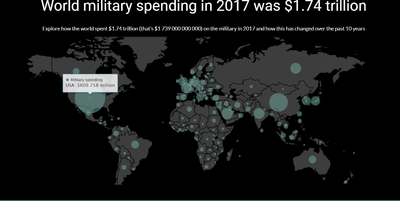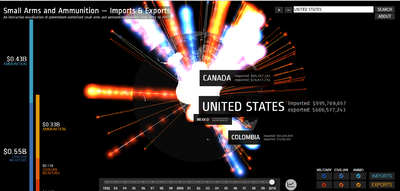Group14 Report
|
|
|
|
|
Contents
Overview
The global arms trade has been a major concern as the international transfer of arms between states could lead to wars, crimes against humanity and contribute to serious violations of international human rights. The Stockholm International Peace Research Institute (SIPRI) conducts research on arms transfers between regions and states aimed at increasing the fundamental understanding of the impact of arms transfers and to support policymaking. SIPRI aims to contribute to greater transparency in the global arms trade to ensure responsible international arms transfers, hence helping to prevent violent conflict, alleviate tensions and warn about potentially destabilizing arms accumulations. Based on the latest publication by SIPRI in 2017, a rising trend is observed in the volume of international transfers of major weapons, with the highest volume of arm transfers recorded between 2013 to 2017, since 1990 [1]. Research conducted by SIPRI also shows that the global arms trade industry is continuing to export weapons into for deadly armed conflicts. [2]
Trend in International Arms Transfers,1978 to 2017
|
|
Motivation and Objectives
Based on the Global Peace Index 2018 published by the Institute for Economics and Peace, we have identified the countries with 'Low' and 'Very Low Peace' global peace index. [3]
Our project aims to identify the trends and patterns in the international arms transfers at the regional and country levels for these countries and we wish to explore the arms trade dependencies of these countries with other countries. We also aim to explore the major importers and exporters of arms weapons and to find out the relationships between the global arm importers and exporters. Our team is motivated to design a dynamic and interactive dashboard to provide students and policymakers a better understanding and holistic view of the global arms trade.
Through our analysis, we hope to address the following:
1) To explore the arms imports at regional and country level
We want to observe the trends in the global arms imports, find out the countries and regions with the highest arm imports and also identify if there are any unusual patterns in the global arm transfers over the years.
2) To explore the arm trade dependencies between countries
We would like to explore the chord diagram and network chart to find out the exchange of arms transfer between countries.
3) Analyse the top exporters of arms
For a particular region or country, we would like to find out which are the top exporters supplying arms and find out the trends in the arms suppliers across the years.
4) Explore the arms imports with the economic and population indicators
Our group wishes to find out if there is a relationship between the economic and population indicators with the arms imports of countries.
Past Works
A number of applications exist for the visualization of arms trade data. SIPRI produced an interactive web platform using data in their published database but focused on military expenditure instead of arms trade flows (http://visuals.sipri.org/).
|
|
More prominently, Google produced an interactive platform visualizing the imports and exports of small arms and ammunition [7]. These applications, while enhancing the interpretability of published data, often focus only on one aspect of the arms trade using a singular visualization technique (http://armsglobe.chromeexperiments.com/).
|
|
To value-add to this, we contribute an application featuring multiple visualizations, each providing a different aspect of exploration. The following sections describe our approach to the problem and how the application was designed and built.
Design Framework
A detail description of the design principles used and data visualisation elements built
Visualisation of Arms Dependencies
To visualise the arm imports dependencies between countries, chord diagram was used.
Package(s) Used The chorddiag package in R allows to create interactive chord diagrams using the JavaScript visualization library D3 from within R using the htmlwidgets interfacing framework.
It is also possible to utilize the circlize package to visualize the chord diagram with added customizable functions to visualize additional plots within the chord diagram. However, circlize package lacks the interactivity for users on the chord diagram itself. For example, users will not be able to highlight trade flows of interest within the chord diagram itself. The chorddiag package requires the data to be in a square matrix format, hence multiple data wrangling had to be performed to ensure that datasets had to be in square matrix format prior to plotting of the chord diagram.
First, the spread function was used to spread the ‘originCountries’ field into multiple columns. Although, there could be no arms trade from Country F to Country D, the data of all the countries has to be presented in square matrix format (Origin-Destination matrix) as shown in Step 1 below. In the square matrix, the row represents the Origin Country (Supplier) and columns refer to the Destination Country (Importer).
In Step 2 as shown below, the process is repeated for each region at each 5 year interval. For example, to find out the the trade inflow of the countries in South Asia during the time period 2013-2017 in the chord diagram, the data has to be prepared in square matrix as shown in Step 1 specifically for import countries in South Asia for the period 2013-2017. In total, there are 6 regions and the breakdown of time period is 5 period, each at 5 year interval. Hence, the data preparation was conducted 30 times (Step 2).
Methodology
Demonstration
Sample test cases
Discussion
What has the audience learned from your work? What new insights or practices has your system enabled? A full blown user study is not expected, but informal observations of use that help evaluate your system are encouraged.
Future Work
A description of how your system could be extended or refined.
Installation Guide
including hardware configuration and software integrationn.
User Guide
Step-by-step guide on how to use the data visualisation functions designed.
References
[1] Stockholm International Peace Research Institute. https://www.sipri.org/research/armament-and-disarmament/arms-transfers-and-military-spending/international-arms-transfers
[2] Amnesty International. https://www.amnesty.org/en/latest/campaigns/2017/09/killer-facts-the-scale-of-the-global-arms-trade/
[3] The Institute for Economics and Peace. http://visionofhumanity.org/indexes/global-peace-index/
| Visualisations | Description |
|---|---|
| 1. Visualisation of Arms Dependencies
Package(s) Used The chorddiag package in R allows to create interactive chord diagrams using the JavaScript visualization library D3 from within R using the htmlwidgets interfacing framework. It is also possible to utilize the circlize package to visualize the chord diagram with added customizable functions to visualize additional plots within the chord diagram. However, circlize package lacks the interactivity for users on the chord diagram itself. For example, users will not be able to highlight trade flows of interest within the chord diagram itself. The chorddiag package requires the data to be in a square matrix format, hence multiple data wrangling had to be performed to ensure that datasets had to be in square matrix format prior to plotting of the chord diagram. First, the spread function was used to spread the ‘originCountries’ field into multiple columns. Although, there could be no arms trade from Country F to Country D, the data of all the countries has to be presented in square matrix format (Origin-Destination matrix) as shown in Step 1 below. In the square matrix, the row represents the Origin Country (Supplier) and columns refer to the Destination Country (Importer). In Step 2 as shown below, the process is repeated for each region at each 5 year interval. For example, to find out the the trade inflow of the countries in South Asia during the time period 2013-2017 in the chord diagram, the data has to be prepared in square matrix as shown in Step 1 specifically for import countries in South Asia for the period 2013-2017. In total, there are 6 regions and the breakdown of time period is 5 period, each at 5 year interval. Hence, the data preparation was conducted 30 times (Step 2).
|
[[] |



